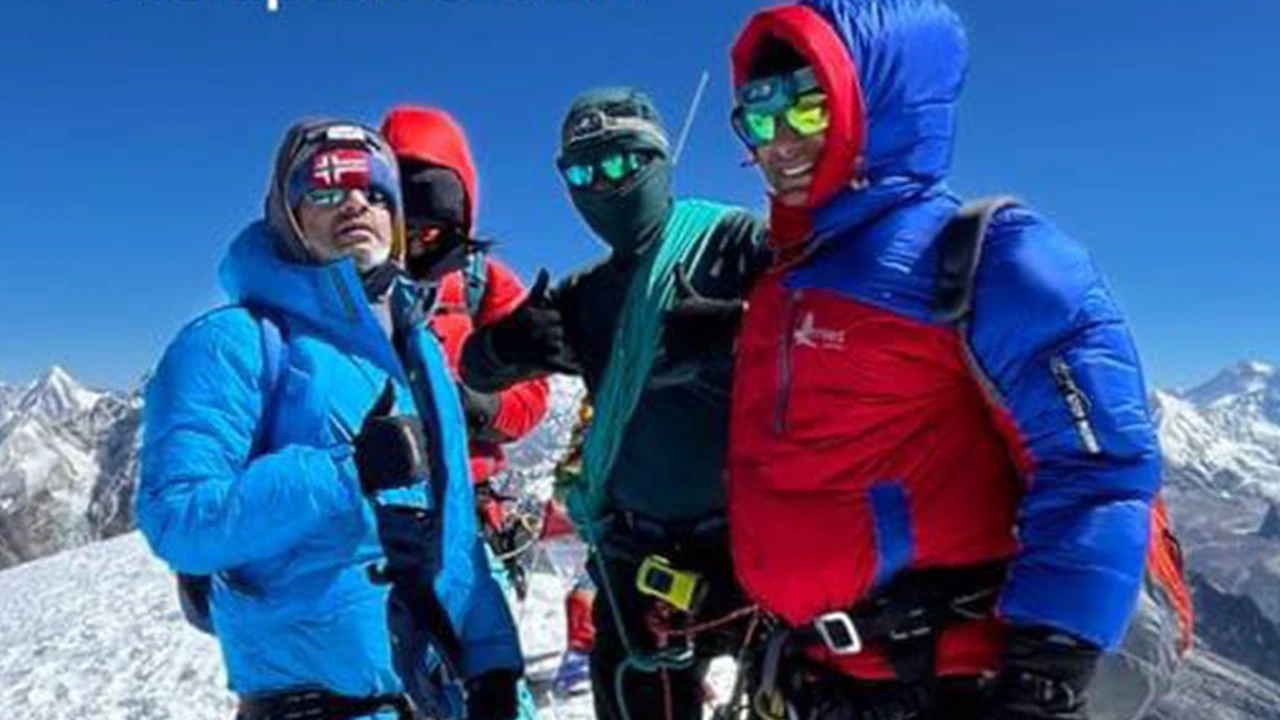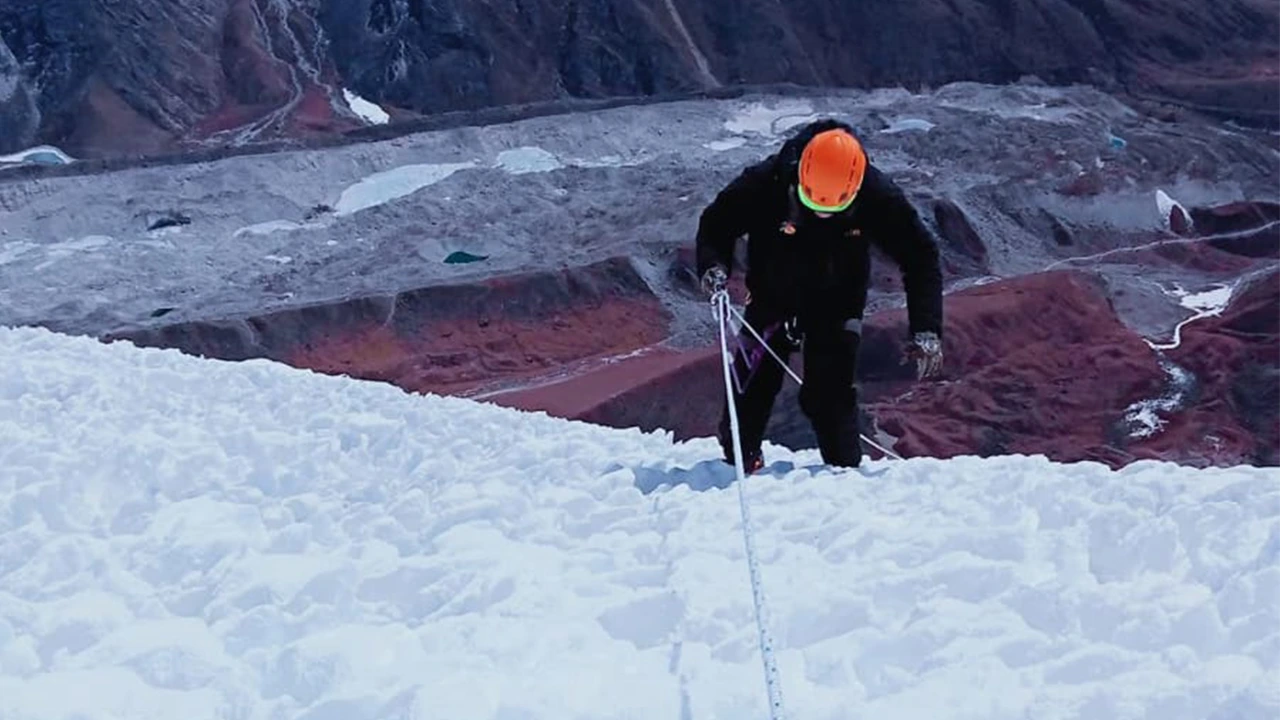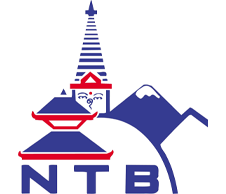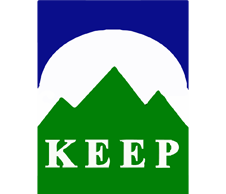Upon arrival at Tribhuvan International Airport, you’ll be warmly welcomed and transferred to your hotel in the heart of Kathmandu. Depending on your arrival time, you can relax after the flight or explore the bustling streets of Thamel, where trekkers and climbers from around the world gather. In the evening, meet your guide for a trip briefing and enjoy your first taste of Nepali cuisine. Overnight at hotel accommodation.
Mera Peak Climbing

Overview
Experience the Mera Peak Climbing adventure in Nepal, designed for trekkers and adventure lovers who want both mountain challenges and cultural experiences. Standing at 6,476 meters, Mera Peak is the highest trekking peak in Nepal, offering climbers wide Himalayan views of Everest, Lhotse, Makalu, Cho Oyu, and Kanchenjunga. This 18-day trip combines mountain climbing, scenic trekking trails, and visits to traditional Sherpa villages across the Everest region.
The journey starts in Kathmandu, Nepal’s lively capital. Upon arrival at Tribhuvan International Airport, a friendly representative will escort you to your hotel. After a welcome briefing, you can explore the streets of Thamel, known for its shops, cafes, and local atmosphere.
Next, you will take a flight to Lukla, the entry point to the Everest region. From there, the trek moves through small Sherpa villages, forests, and rivers, giving you a chance to experience the local culture. Along the way, you’ll pass through Phakding, Namche Bazaar, Tengboche, Dingboche, and Khumjung, each offering a glimpse into the Sherpa lifestyle, monasteries, and mountain traditions.
The trek includes acclimatization days in Namche Bazaar and Dingboche to prevent altitude sickness. On the trail, trekkers enjoy clear views of the Himalayas, including Ama Dablam, Nuptse, Lhotse, and Island Peak, making each day of trekking rewarding.
The climbing portion starts from Mera High Camp, where guides provide training for ice climbing, rope use, and summit preparation. The summit day is challenging but highly rewarding, as you reach the highest trekking peak in Nepal and see panoramic views of multiple Himalayan peaks. After descending safely, the trail returns through scenic villages to Lukla before flying back to Kathmandu.
This 18-day adventure is not only about climbing; it also offers cultural insights, local food experiences, and peaceful mountain landscapes. From the busy streets of Kathmandu to remote high-altitude villages, the Mera Peak Climbing gives a complete Himalayan experience.
By the end of the trip, climbers return to Kathmandu with memories of the summit, Himalayan views, and Sherpa culture, making it a rewarding journey for any adventure seeker.
Major Highlights of Mera Peak Climbing 18 Days:
- Summit Mera Peak (6,476m), the highest trekking peak in Nepal.
- Enjoy panoramic Himalayan views including Everest, Lhotse, Makalu, Cho Oyu, and Kanchenjunga.
- Explore famous Sherpa villages: Namche Bazaar, Tengboche, Dingboche, Khumjung.
- Trek through the Everest region, passing forests, rivers, and valleys.
- Learn about Sherpa culture, monasteries, and local traditions.
- Include acclimatization days for a safe climb.
- Receive technical climbing training and ice climbing experience with expert guides.
- Return via scenic Lukla flight, enjoying mountain vistas from above.
Today is reserved for expedition preparation. Your guide will check your gear, help with any last-minute shopping, and finalize permit formalities. Kathmandu offers excellent trekking shops where you can rent or purchase mountaineering equipment. If time allows, you may also visit cultural landmarks such as Boudhanath Stupa or Pashupatinath Temple. Overnight at hotel accommodation.
After an early morning drive to Ramechhap (4–5 hrs), take a short but spectacular flight to Lukla. Here, the adventure officially begins with the first encounter of crisp mountain air and bustling Sherpa culture. The rest of the day is dedicated to acclimatization around Lukla. You can enjoy short hikes and scenic views of nearby peaks while preparing for the days ahead. Overnight at a lodge in Lukla.
Leaving Lukla, the trail heads east through forests of pine and rhododendron. Gradual ascents bring you to the small settlement of Chutanga, surrounded by rolling green hills. This stage allows your body to slowly adjust to increasing altitude. Overnight at a lodge.
A challenging day begins with a steep climb to Zatrawa La Pass (4,610 m), where breathtaking views of Numbur Himal and the surrounding peaks unfold. From the pass, you descend along rocky terrain to reach Thuli Kharka (also called Chatra-La), a grazing area with stone huts. Overnight in a mountain lodge.
The trail winds through forests of rhododendron and juniper, with opportunities to spot Himalayan wildlife. Gradually, you gain altitude while following the Hinku Valley until reaching Kothe, a beautiful village on the banks of the Hinku River. Overnight in a teahouse with warm meals.
A relatively short day of trekking brings you to Thangnak, passing through alpine meadows and pastures where yaks graze. The trail offers fantastic views of the south face of Mera Peak, building excitement for the climb. Overnight in a lodge.
Today is an important acclimatization day. You will hike to Sabal Tsho Lake and ascend to a large cairn at 5,271 m on the flanks of Kusum Kanguru (6,367 m). This rewarding climb provides panoramic views and prepares your body for higher altitudes. Return to Thangnak for rest. Overnight at a lodge.
A steady uphill trek leads you to Khare, the last settlement before Mera Peak. The trail ascends through moraine and rugged terrain with magnificent views of Mera Glacier. Overnight in a lodge.
Today, you climb steep slopes and navigate icy terrain with the help of your climbing team. The route involves glacier travel and requires the use of crampons. At Mera High Camp, you’ll camp in tents beneath towering peaks, with breathtaking views of Everest, Lhotse, and Makalu at sunset.
A pre-dawn alpine start leads you across glaciers under starlight. The climb includes gradual snow slopes and a final steep ascent to the summit of Mera Peak (6,476 m). From the top, you’ll enjoy one of the finest Himalayan panoramas, with Everest, Makalu, Kanchenjunga, and Cho Oyu in view. After celebrating, descend carefully to Khare. Day 12 is reserved as a contingency for weather or rest. Overnight in a lodge.
The descent is rewarding, as oxygen-rich air makes walking easier. Retracing your steps, you follow the Hinku Valley back to Kothe. Overnight in a teahouse.
Climbing gradually, you re-enter the alpine meadows of Thuli Kharka. This scenic day provides excellent views of Mera Peak behind you. Overnight in a lodge.
The final trekking day is both challenging and rewarding. You ascend again to Zatrwa La Pass before making a long descent to Lukla. This evening is your last in the mountains, and a farewell celebration with your trekking crew makes it memorable. Overnight in a lodge.
Take a scenic morning flight back to Ramechhap, followed by a drive to Kathmandu. After checking into your hotel, you can relax, enjoy hot showers, and revisit the lively streets of Thamel. Overnight at hotel accommodation.
This buffer day allows flexibility for potential flight delays from Lukla. If all runs on time, you can spend the day exploring Kathmandu’s historic squares or shopping for handicrafts. In the evening, enjoy a farewell dinner with traditional Nepali cultural performances. Overnight in a hotel.
After breakfast, you’ll be transferred to Tribhuvan International Airport for your international departure. As your plane takes off, you bid farewell to Nepal and its majestic mountains, carrying unforgettable memories of your Mera Peak adventure.
Cost Includes
- Airport transfers in Kathmandu (arrival and departure).
- Domestic flights: Kathmandu–Lukla–Kathmandu.
- Accommodation in Kathmandu: 3–4 star hotels with breakfast.
- Teahouse/lodge accommodation during the trek.
- All meals during the trek (breakfast, lunch, and dinner).
- Professional climbing guides and Sherpa support team.
- Mera Peak climbing permits and national park entry fees.
- Necessary climbing equipment: ropes, ice axes, harnesses, and crampons (personal gear not included).
- Trekking and climbing staff: porters for luggage and support.
- Government and local taxes.
- Briefing and orientation before the trek.
- Emergency evacuation arrangements during the trek.
Cost Excludes
- Personal travel insurance (mandatory to cover high-altitude trekking and climbing).
- International airfare to/from Kathmandu.
- Visa fees for Nepal.
- Personal climbing equipment: gloves, boots, jacket, sleeping bag, etc.
- Tips for guides, porters, and drivers.
- Beverages, alcohol, snacks, or bottled water during the trek.
- Optional activities or sightseeing outside the itinerary.
- Laundry, phone calls, and personal expenses.
FAQs
Mera Peak is considered one of the highest trekking peaks in Nepal, standing at 6,476 meters (21,247 ft). The climb is suitable for individuals with good physical fitness and basic trekking experience, but it also requires ice climbing skills for the final summit sections. While the trek itself involves moderate to challenging trails, the summit push demands stamina, focus, and experience in using climbing equipment such as crampons, ice axes, and ropes. Prior altitude experience is highly recommended to reduce the risk of altitude sickness.
The ideal seasons for Mera Peak climbing are pre-monsoon (March to May) and post-monsoon (September to November). During these months, the skies are generally clear, offering panoramic views of Everest, Makalu, Lhotse, and Cho Oyu. Winter months can be very cold with heavy snow, making climbing riskier, while the monsoon season (June to August) brings heavy rainfall, slippery trails, and limited visibility.
Most climbers start their journey with a domestic flight from Kathmandu to Lukla, which takes around 35–40 minutes. Lukla is the gateway to the Khumbu region, and from here, trekkers follow the trails through villages such as Chukung and Khare en route to Mera Peak Base Camp. For those who prefer overland travel, a long drive combined with trekking is also possible, but it is less common due to the convenience of the Lukla flight.
Yes, the summit sections of Mera Peak require technical climbing gear. Essential items include mountaineering boots, crampons, ice axes, harnesses, helmets, and ropes. Your trekking company or guides usually provide some shared equipment like ropes and fixed lines, but climbers are responsible for personal high-altitude clothing, gloves, and boots. It is strongly advised to train with your gear before the climb to ensure comfort and safety.
While Mera Peak is classified as a trekking peak, beginners must be well-prepared physically and willing to undergo training in basic climbing techniques. Hiring a professional guide and porter team is essential, as they provide instruction, safety support, and route guidance. Beginners with determination and prior trekking experience can reach the summit, but proper acclimatization and gradual ascent are crucial.
Mera Peak offers climbers incredible panoramic views of five 8,000-meter peaks: Everest, Lhotse, Cho Oyu, Makalu, and Kanchenjunga. Along the way, trekkers experience traditional Sherpa villages, Buddhist monasteries, rhododendron forests, and high-altitude landscapes. The journey also includes Khumbu Valley culture, local hospitality, and the challenge of high-altitude mountaineering, making it a memorable adventure for both trekkers and climbers.
Preparation is key for a successful climb. Focus on cardiovascular training, leg strength, and endurance for long trekking days. Activities such as hiking with a weighted backpack, stair climbing, and aerobic exercises are highly recommended. Additionally, practicing ice climbing or using crampons before the expedition can boost confidence during the summit push. Adequate preparation reduces the risk of fatigue and altitude-related issues.
A comprehensive package typically includes domestic flights, airport transfers, accommodation in Kathmandu and teahouses/lodges on the trek, meals during trekking, climbing permits, professional guides, porters, and climbing equipment. Items like personal gear, insurance, tips, and optional activities are generally excluded, so climbers should plan accordingly.
Yes, altitude sickness is a common risk above 3,000 meters, and Mera Peak’s summit reaches over 6,400 meters. Gradual acclimatization, hydration, and following the guide’s instructions are essential. Some trekkers carry medications like Diamox after consulting a doctor. Most companies also have emergency evacuation plans in case of severe altitude sickness.
The typical itinerary spans 18 days, including time for acclimatization, trekking through villages, and the summit attempt. This schedule allows for a gradual ascent, rest days, and opportunities to explore the Khumbu region before returning to Kathmandu.
Mera Peak Climbing
Trekking & Hiking Adventure




